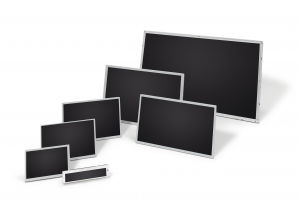In a world where so many things are declared ‘revolutionary’, we try to exercise caution. But the combination of Ultra-Low Power TFT (Thin-Film Transistor) and Projected Capacitive Touch (PCT™) has opened up new possibilities for energy-efficient human-machine interfaces (HMIs). To us, it feels like the word definitely qualifies here, but we should probably take the opportunity to explain why, how these technologies work, their importance in the market and their advantages over ePaper displays.

1.45” round ULP TFT
Why do Ultra-Low Power TFT displays matter?
Number one has got to be energy efficiency. Ultra Low Power TFTs consume significantly less energy, compared to conventional TFTs. This makes them ideal for battery-powered devices, wearables, and IoT applications where power efficiency is critical.
Secondly, – vivid visuals. Even though their power consumption is low, these displays are vibrant. They’re equally crisp enough for consumer products, like smartwatches, or medical devices that requires absolute clarity. High resolution, fast refresh rates and zero compromise on battery life? This is game-changing for portable devices.
Plus, Ultra-Low Power TFTs are versatile and customizable. Manufacturers can tailor the display size, shape, and functionality to suit the application. From curved screens to unique form factors, there are so many possibilities
How do they work?
Ultra-Low Power TFTs use silicon-on-thin-buried oxide (SOTB) technology, at the heart of which are:
- Fully Depleted Silicon-on-Insulator (FDSOI) Transistors operate at low voltages and exhibit excellent back-bias controllability.
- The Thin Buried Oxide Layer enhances back-bias control and allows monolithic integration with conventional bulk CMOS circuits.
- Ultra Low Power TFTs take advantage of low-voltage operation, reducing both active and standby power consumption.
Where can they be used?
As we mentioned above, there’s plenty of scope for wearable tech – smartwatches and fitness bands are good examples. However, we also need to consider the world of extended reality too, as it would benefit from prolonged battery life without sacrificing touch functionality. Smart home interfaces are a less glamourous, but really important in terms of the customizable and versatile nature of Ultra-Low Power TFTs. However, we feel that healthcare devices is where this technology will really shine. Medical wearables, such as glucose monitors and ECG devices would be the perfect use case for Ultra-Low Power TFTs and PCT™.
What are their advantages over ePaper displays?
While ePaper displays have plenty of their own merits, Ultra-Low Power TFTs have the edge in so many ways:
Faster Refresh Rates: ePaper displays are known for their slow refresh rates, making them suitable for static content like e-readers. Ultra-Low Power TFTs, on the other hand, can handle dynamic content, animations, and video playback.
Color Capabilities: Most ePaper displays are monochromatic or limited to grayscale. Ultra-Low Power TFTs can reproduce full-color images, making them more appealing for multimedia applications.
Sunlight Readability: Both technologies are reflective, but Ultra-Low Power TFTs give better visibility in direct sunlight. Their backlit-free design means that they are readable even in bright outdoor conditions.
Thin and Flexible: Ultra-Low Power TFTs can be manufactured on flexible substrates (like PET plastic, for example), making them thin, lightweight, and adaptable to curved surfaces. This flexibility opens up new design possibilities.
We don’t know about you, but we think the possibilities that this technology presents certainly feels revolutionary. And while we are only using examples in consumer and medical right now, the introduction of Ultra-Low Power TFTs in smart homes, factories, retail and a world of other spaces feels realistic and inevitable. The potential is huge and we’re here for it.
Our experts are on hand to guide you in the creation of display or touch solutions that meet your requirements. Find out how Avnet Embedded can propel your product innovation and get in touch today.
Talk to the experts!
Let us know about your product or your challenge and our team will get in touch to discuss how we can help.
Click here to add your own text




